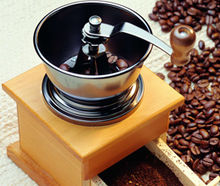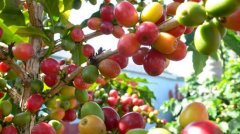Island coffee boutique coffee black coffee producing area coffee
St. Helena (St.Helena) aroma 3.5 minutes brightness 4 minutes mellow 4 minutes flavor 4.5 points aftertaste 4.5 points
Suitable for baking: people who like sour taste in City/Full city can bake to city, while if you want to show a balanced flavor of island coffee, you can bake to full city, just a little deeper.
Remember where Napoleon was banished after his defeat? Yes, it is St. Helena Island! I didn't expect that this 8-mile-long and 6-mile-wide island also produces coffee. St. Helena not only produces coffee, but also produces very good coffee! Of course, the annual output of the island must be pitifully small, and a bunch of coffee critics have greatly praised St. Helena's coffee as excellent, so the price is unmatched by ordinary people! St. Helena grows ancient Yemeni species, which, coupled with careful care, eventually produces very high-quality coffee beans. St. Helena coffee tastes medium, with a shallow but bright fruit aroma, in addition to the spice flavor, the overall performance is quite balanced. The only problem is that it may be hard to get!
Dominica (Dominican) aroma 4 minutes brightness 4 minutes mellow 4 points flavor 4 points aftertaste 4 points
Suitable for roasting: City/Full ctiy, like other island coffee, is not suitable for roasting too deep, and the flavor of Dominican coffee can be best shown between City and Full City.
Dominica, like Jamaica, is an island in the Caribbean and a famous producer of boutique coffee beans. There are several famous producing areas in the country: Bani, Barahona and Ocoa. Although Dominica is an island coffee, the price is not as high as other island coffee. Friends who like the clean flavor of washed beans can give it a try.
Island coffee is often separated from other coffee producing areas and is classified separately. These island coffees have two main characteristics: one is that they are famous, like Blue Mountain and Kona, and those who do not drink coffee have heard of it. The other is dead expensive! Because of the limited planting area, the output of island coffee is very small, and the food is scarce. Island coffee usually has the characteristics of rich milk and floral aroma, and the taste is often meticulous and bright, and most island coffee has a high standard of raw bean treatment, beautiful bean shape and low defect rate.
Hawaii (Hawaii) aroma 3.5 minutes brightness 4.5 minutes mellow 3.5 minutes flavor 4.5 points aftertaste 4.5 points
Suitable baking degree: City/Full city generally recommends baking to the middle of the second explosion, but it is also good at the beginning of the second explosion.
Hawaii is the only coffee-producing state in the United States, which is produced on the island of Kona, one of the islands of Hawaii. The average level of Kona beans is very high, and the processing is also very careful. Generally speaking, the poor defective beans in raw beans are between 10% and 30%, but Kona's defective beans are calculated on the basis of "pieces". Usually a pound of Kona beans can't pick out 10 defective beans! The top coffee beans are called Extra Fancy, and the secondary coffee beans are called Fancy. The difference between the two is mainly the particle size. It tastes very similar to high-altitude Central American beans and is quite rich in taste. Because of the low output and high wages, the price is high. Recently, coffee beans have been grown in other islands of Hawaii, and there are even knockoffs on the market, so be careful when buying them.
Puerto Rico (Puerto Rico) aroma 3.5 minutes brightness 4 minutes mellow 3 minutes flavor 4.5 points aftertaste 4 points
Suitable baking degree: the overall feeling of City/Full citycity baking is closest to Blue Mountain, and the palate is fullest when full city.
If you like the taste of Blue Mountain Coffee very much, but your bank account can't support you, then your choice is Puerto Rico! Puerto Rico's Yauco selecto has 80% of the strength of Blue Mountain, but the price is only half that of Blue Mountain! Strong creamy taste and medium consistency taste, with elegant sour taste, taste very soft. Yukot chooses less than 1% of the island's annual output, coupled with complicated and meticulous processing procedures and expensive local wages, so it can't be expensive. Although the price is the same as that of Kona in Hawaii, it is already much cheaper than Blue Mountain.
Jamaica (Jamaica) aroma 3.5 min brightness 4 min mellow 4% flavor 5% aftertaste 5%
Suitable baking degree: baking in City, baking at most until the second explosion is just about to begin.
Located in the Caribbean, Jamaica is the famous birthplace of Blue Mountain Coffee. The legendary delicious coffee comes from the high mountains to the east of Jamaica. The earliest Blue Mountain Coffee came from several estates. Later, the Jamaican government laid down a set of regulations. As long as it is produced in the Blue Mountains, the name "Blue Mountain" can be used for tree species and processing procedures. But in fact, the good Blue Mountain Coffee is still those estates. The price of the real Blue Mountain is so high that the retail price of a pound of raw beans is nearly four or five hundred. But supply often falls short of demand! A good Blue Mountain has a medium consistency ear flavor, creamy and drupe flavor, plus a floral hint of acidity. According to the laws of economics, Lanshan is so expensive because of its low production. Is it really delicious to drink? That depends on personal liking. Of course, because the price is expensive and profitable, there are a lot of fake Blue Mountain coffee beans, and these beans are still known as "authentic Blue Mountain"!

Important Notice :
前街咖啡 FrontStreet Coffee has moved to new addredd:
FrontStreet Coffee Address: 315,Donghua East Road,GuangZhou
Tel:020 38364473
- Prev

Understand coffee professional words and nouns about coffee
Arabica coffee: one of the three original varieties of coffee, the other two are Robusta and Liberika. Among the three original species, Arabica has the best quality, but it is also the easiest to wilt when cultivated.
- Next

The technical term "coffee" in Italian coffee comes from the Greek word "Kawen".
The word coffee comes from the Greek word Kawen, which means strength and enthusiasm. The name coffee comes from the Arabic word Qahwan, which means plant drink. Later, coffee spread all over the world and was named after its place of origin, KAFFA. It was not officially named after coffee until the 18th century. From the first cup of mellow coffee, after two hundred years, in 1530, the world
Related
- Beginners will see the "Coffee pull flower" guide!
- What is the difference between ice blog purified milk and ordinary milk coffee?
- Why is the Philippines the largest producer of crops in Liberia?
- For coffee extraction, should the fine powder be retained?
- How does extracted espresso fill pressed powder? How much strength does it take to press the powder?
- How to make jasmine cold extract coffee? Is the jasmine + latte good?
- Will this little toy really make the coffee taste better? How does Lily Drip affect coffee extraction?
- Will the action of slapping the filter cup also affect coffee extraction?
- What's the difference between powder-to-water ratio and powder-to-liquid ratio?
- What is the Ethiopian local species? What does it have to do with Heirloom native species?

